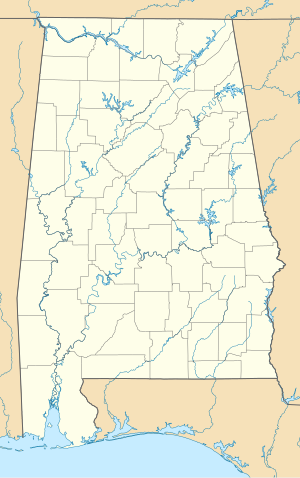
The Confederate States Marine Corps (CSMC), also referred to as the Confederate States Marines, was a branch of the Navy during the American Civil War. It was established by an act of the Provisional Congress of the Confederate States on March 16, 1861. The Corps' manpower was initially authorized at 45 officers and 944 enlisted men, and was increased on September 24, 1862, to 1,026 enlisted men. The organization of the Corps began at Montgomery, Alabama, and was completed at Richmond, Virginia, when the capital of the Confederate States was moved to that location. The headquarters and main training facilities remained in Richmond throughout the war, located at Camp Beall on Drewry's Bluff and at the Gosport Shipyard in Portsmouth, Virginia. The last Marine unit surrendered to the Union army on April 9, 1865, with the Confederacy itself capitulating to the U.S. federal government a month later.

The siege of Corinth was an American Civil War engagement lasting from April 29 to May 30, 1862, in Corinth, Mississippi. A collection of Union forces under the overall command of Major General Henry Halleck engaged in a month-long siege of the city, whose Confederate occupants were commanded by General P.G.T. Beauregard. The siege resulted in the capture of the town by Federal forces.

The 15th Pennsylvania Cavalry Regiment, known as the Anderson Cavalry and the 160th Volunteers, was a three-year cavalry regiment in the Union Army during the American Civil War. It was recruited and formed in the summer of 1862 by officers and men of the Anderson Troop, an independent company of the Pennsylvania Volunteers that had been mustered the previous November.
Wilson's Raid was a cavalry operation through Alabama and Georgia in March–April 1865, late in the American Civil War. Brig. Gen. James H. Wilson led his Union Army Cavalry Corps to destroy Southern manufacturing facilities and was opposed unsuccessfully by a much smaller force under Confederate Lt. Gen. Nathan Bedford Forrest.

Louisville in the American Civil War was a major stronghold of Union forces, which kept Kentucky firmly in the Union. It was the center of planning, supplies, recruiting and transportation for numerous campaigns, especially in the Western Theater. By the end of the war, Louisville had not been attacked once, although skirmishes and battles, including the battles of Perryville and Corydon, took place nearby.
The 7th Wisconsin Infantry Regiment was an infantry regiment that served in the Union Army during the American Civil War. It was a component of the famous Iron Brigade in the Army of the Potomac throughout the war.
The 17th Wisconsin Infantry Regiment was an infantry regiment that served in the Union Army during the American Civil War. It was popularly known as the Irish Brigade, due to its composition of mostly Irish American immigrants.
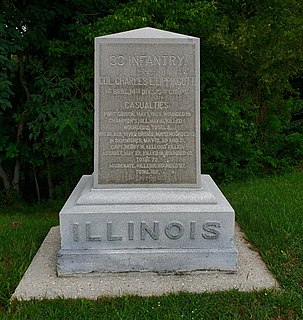
The 33rd Illinois Infantry Regiment was an infantry regiment from Illinois that served in the Union Army during the American Civil War. A number of the soldiers were college students and graduates, and for a time the regiment included a 17-piece band. The unit fought at Fredericktown in 1861, Cotton Plant in 1862, the Vicksburg campaign and Fort Esperanza in 1863, and at Spanish Fort in 1865. The original enlistees were mustered out in October 1864 while the veterans and recruits were mustered out in December 1865.
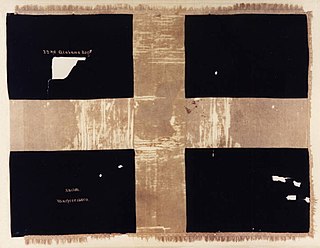
The 22nd Alabama Infantry Regiment was an infantry regiment that served in the Confederate Army during the American Civil War.

The 123rd Regiment Illinois Volunteer Infantry, was an infantry and mounted infantry regiment that served in the Union Army during the American Civil War. In 1863 and 1864 it was temporarily known as the 123rd Illinois Volunteer Mounted Infantry Regiment, as part of Wilder's Lightning Brigade.
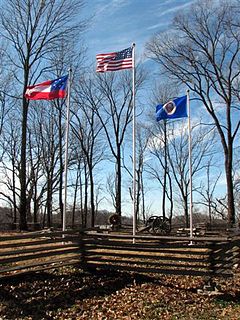
The 114th Illinois Infantry Regiment was an infantry regiment from Illinois that served in the Union Army during the American Civil War. Formed in September 1862, the regiment served in Ulysses S. Grant's Central Mississippi campaign, in the Vicksburg campaign, at Brices Cross Roads, at Tupelo, in the 1864 Missouri campaign, at Nashville, and at Spanish Fort. At Nashville, the unit participated in the decisive attack on Shy's Hill. In 1865, the regiment was reassigned as pontoniers. The regiment was mustered out in August 1865.
The 10th Kentucky Infantry Regiment was an infantry regiment that served in the Union Army during the American Civil War.
The 73rd Regiment Indiana Infantry was an infantry regiment that served in the Union Army during the American Civil War.
The 72nd Indiana Infantry Regiment, also known as 72nd Indiana Mounted Infantry Regiment, was an infantry and mounted infantry regiment that served in the Union Army during the American Civil War. The regiment served as mounted infantry from March 17, 1863, to November 1, 1864, notably as part of the Lightning Brigade during the Tullahoma and Chickamauga Campaigns.

James Holt Clanton was an American soldier, lawyer, legislator, and was later also a Confederate combatant. He enlisted in the United States Army for service during the Mexican–American War, and later was a Confederate Army brigadier general during the American Civil War. Following the war he returned to practicing law and later was murdered in a private feud in Tennessee.

The Second Battle of Pocotaligo, or Battle of Pocotaligo Bridge, or Battle of Yemassee, often referred to as simply the Battle of Pocotaligo, was a battle in the American Civil War on October 22, 1862 near Yemassee, South Carolina. The Union objective was to sever the Charleston and Savannah Railroad and thus isolate Charleston, South Carolina.
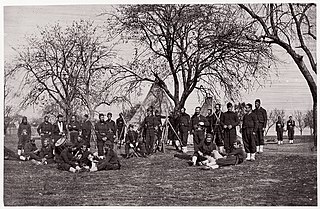
The 164th New York Infantry Regiment was an infantry regiment in the Union Army during the American Civil War.
The 119th Regiment, Illinois Volunteer Infantry was an infantry regiment in the Union Army during the American Civil War.

The 1st Louisiana Regulars Infantry Regiment, often referred to as the 1st Louisiana Infantry Regiment, was an infantry regiment from Louisiana that served in the Confederate States Army during the American Civil War.
The 3rd Missouri Light Battery was an artillery battery of the Confederate States Army during the American Civil War. The battery originated as a Missouri State Guard unit active in late 1861, and was officially transferred to the Confederate States Army on January 28, 1862. The battery provided artillery support at the Battle of Pea Ridge in March 1862, and was lightly engaged at the Battle of Iuka in September. In October 1862, the battery was lightly engaged at the Second Battle of Corinth and saw action at the Battle of Davis Bridge, where it lost at least one cannon. The 3rd Light Battery saw action at the Battle of Champion Hill on May 16, 1863, and had its cannons captured at the Battle of Big Black River Bridge the next day. After participating in the Siege of Vicksburg, the battery was captured on July 4, 1863 and was paroled and exchanged. The battery was then consolidated with the Jackson Missouri Battery; the 3rd Light Battery designation was continued. In early 1864, the battery received replacement cannons and was assigned to the defense of Mobile Bay. The 3rd Light Battery saw action at the Battle of Spanish Fort in March and April 1865. When the Confederate Department of Alabama, Mississippi, and East Louisiana surrendered on May 4, 1865, the battery was again captured; the men of the battery were paroled on May 10, ending their military service.
